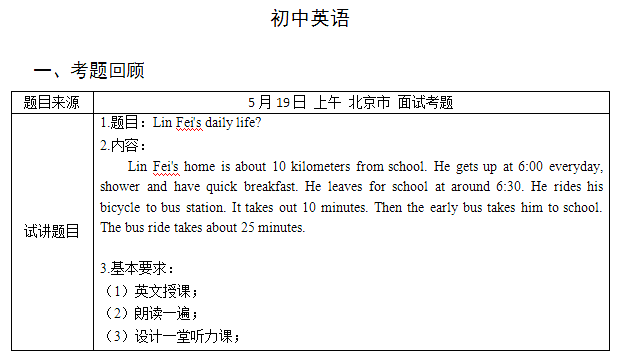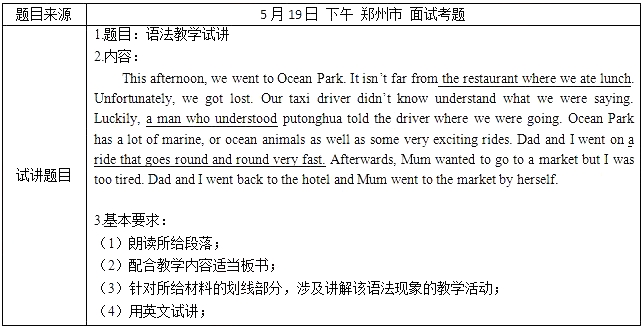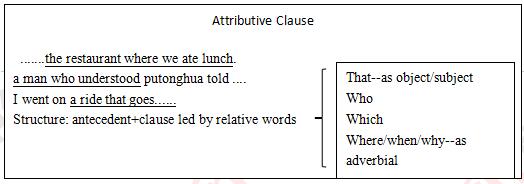作者:陕师大教师资格证培训中心
添加时间: 2018-11-18 10:16:19内容摘要:2018年上半年初中英语教师资格面试试题(精选)第二批。初中英语《Attributive Clause》。

二、考题解析
【教案】
Teaching Aims:
Knowledge aim: Students will be able to describe their daily life and acquire some knowledge about listening strategies.
Ability aim: Students can obtain the main idea quickly from the listening material and develop the ability of grasping detail information.
Emotional aim: Students can foster the interest and desire of learning English, and be fond of taking part in kinds of practical activities.
Teaching Key Points:
Students can get the main idea and useful information from the listening material.
Teaching Difficult Points:
Students can apply these skills in their listening and apply these expression in their daily communication.
Teaching Methods:
Communicative teaching method, task-based teaching method, audio-lingual teaching method.
Teaching Aids:
PPT, Blackboard, recorder and so on
Teaching Procedures:
Step 1: Warming up
1.Greetings
2.Sing an English song It' my life, invite the whole students to clap when singing together and lead to the topic.
Step 2: Pre-listening
1.Free talk: Give students three minutes to talk about their own daily life and invite them to share it.
2.Prediction: Let students work in pairs and ask them to predict Lin Fei's daily life.
Step 3: While-listening
1. Listen to the tape for the first time and ask them when Lin Fei gets up and when he goes to school, then let students to share answers.
2.Listen to the tape for the second time and ask them to fill in the chart, then invite them to share their answers.
Step 4: Production
1.Retelling: Ask students to retell Lin Fei's daily life with the help of the chat in their own words, and teacher will give them 3 minutes to prepare it and 3 minutes later, invite some students to share their retelling in the front.
2.Survey: Let students discuss their own daily life in the group of four and make a report in the form of chart. 8 minutes later teacher invites some groups to share the result of their reports.
Step 5: Summary & Homework
Summary : Invite a little teacher to help teacher make a summary of this class.
Homework: Let students introduce their daily life to their parents and make a share in the next class.
Blackboard design:


二、考题解析
【教案】
Teaching Aims:
Knowledge aim: Students will master the sentence structure “We have great bags for only ¥12! we have....for only....; You can buy...for only .... ”.
Ability aim: Students can use these sentence structures to apply in their daily life.
Emotional aim: Students will improve their confidence of learning English and not afraid of speaking English in Class.
Teaching Key Points:
Students know the expressions about describing great sale and master the sentence structure.
Teaching Difficult Points:
Students can apply the expressions into daily communication.
Teaching Methods:
Communicative teaching method, task-based teaching method, situational teaching method.
Teaching Aids:
PPT, Blackboard and so on
Teaching Procedures:
Step 1: Warming up
1.Greetings
2.Play a video about an advertisement of Huawei phone and invite students to talk about the content of this video.Then the teacher leads in the topic of “Huaxing’s great sale.”
Step 2: Pre-speaking
1.Show two pictures about Huaxing store and its great sale advertisement.
2.Let students listen to the tape and find out what things are at great sale.
3.Ask students to listen to the tape again and collect the useful expressions about great sale.
Step 3:While-speaking
1. Ask students to read Huaxing’s store’s advertisement actively and vividly.
2. Let students talk about the expressions of great sale.
3. Role-play: students work in pairs to make conversation.Suppose there is a situation that you own a store. One student is shop assistant, the other students is customer. Teacher will give them 8 minutes to prepare it.
Step 4: Post-speaking
Share and evaluation: Invite some students to perform the conversation in the front.
Step 5: Summary & Homework
Summary: let them look at the blackboard and summarize this class.
Homework: Ask students to design a poster of their own store’s great sale and share it next class.
Blackboard design:

初中英语《Attributive Clause》
一、考题回顾

二、考题解析
【教案】
Teaching Aims:
Knowledge aim: Students will master the structure of attributive Clause and understand what the relative words or antecedents are.
Ability aim: Students can use the attributive clause to describe what happened in their daily life and make up more superior sentences.
Emotional aim: Students will be inspired to study both English and putonghua very well so that they can solve problems they will meet abroad by themselves.
Teaching Key Points:
Students acquire the clause structure and know the relative words as well as antecedents.
Teaching Difficult Points:
Students can apply the structure into daily communication and get the difference between relative pronoun and adverb.
Teaching Methods:
Communicative teaching method, task-based teaching method, situational teaching method.
Teaching Aids:
PPT, Blackboard and so on
Teaching Procedures:
Step 1: Warming up
1.Greetings
2.Review: Show students two sentences. One is an adverbial clause of place that linked by where and the other is an attributive clause that also linked by where Where there is a will there is a way. Let them find out the differences or similarities between them and lead to what we’re going to learn today.
Step 2: Presentation
1. Read the passage briefly and and answer 3 questions. Where is the Ocean park? Who helped us? How was the ride? To lead the three underlined parts Then write down the three sentences students choose from the passage after reading.
2.Explain the common parts of these three sentences and show the structure of attributive clause.
3.Tell students that when the antecedent is a person or an object, we should choose different relative words. Also, they should understand the difference between attributive clause linked by where and the adverbial clause of place linked by where.
Step 3: Practice
1. Give them some sentences with blankets and let them choose the proper relative words.
2. Show them several clauses and find out which are attributive clauses.
Step 4: Production
Discussion and share: students work in pairs to describe their travel by using attributive clauses; teacher will give them 5 minutes to prepare it and 5 minutes later, invite some students to share their experiences.
Step 5: Summary & Homework
Summary : students look at the blackboard and summarize this class.
Homework:students find more rules about attributive clauses and prepare for the next class.
Blackboard design:

- 2018年上半年初中英语教师资格面试试题(精选)...
2018-11-18
- 2018年上半年初中英语教师资格面试试题(精选)...
2018-11-18
- 2018年上半年初中英语教师资格面试试题(精选)...
2018-11-18
- 2018年上半年小学语文教师资格面试试题(精选)...
2018-11-15
- 2018年上半年小学语文教师资格面试试题(精选)...
2018-11-15








